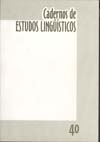Resumo
In this paper, the role of human bodily experience in the generation of metaphors in language and thought is investigated through empiric linguistic and psycholinguistic studies on the DESIRE IS HUNGER metaphor. Based on Grady’s hypothesis (1997), which suggests a direct link between the recurrence of universal particular bodily experiences and the generation of primitive conceptual metaphors, we investigated how American English and Brazilian Portuguese speakers metaphorically conceptualize desire in terms of hunger. Our results were congruent with Grady’s hypothesis, showing that what people know about their embodied experiences of hunger allows them both to predict which aspects of desire will, and will not, be thought of, and talked about, in terms of their embodied understandings of hunger, and to understand metaphorical expressions about human desires, such as politicians hunger for power or these children hunger for affection. Moreover, we analyzed the DESIRE IS HUNGER metaphor productivity, which was shown to be very high and was also shown to be employed in different discourse genres and in many areas of human knowledge, in both languages.Referências
DEIGNAN, Alice. (1997). Metaphors of desire. In HARVEY, K. & SHALOM, C. (eds.), Language and desire: enconding sex, romance and intimacy (pp.21-42). London, New York: Routledge.
DIRCKX, John H. (1992). As confusões anatômicas na linguagem cotidiana. In: Ciência e Futuro 1992 (pp.94-109). Livro do Ano. Encyclopaedia Britannica do Brasil.
DUMESNIL, René. (1935). Histoire illustrée de la médecine. Paris: Librairie Plon.
EMANATION, Michele. (1995). Metaphor and the expression of emotion: the value of cross-cultural perspectives. Metaphor and Symbolic Acitivity 10 (3):163-182.
GIBBS, Raymond W., Jr. (1994a). Figurative thought and figurative language. In: M.A. GERNSBACHER (Ed.) Handbook of psycholinguisitics (p.411-446). San Diego: Academic Press.
GIBBS, Raymond W., Jr. (1994b). The poetics of mind: figurative thought, language, and understanding. Cambridge: Cambridge University Press.
GIBBS, Raymond W., Jr. (1996). Why many concepts are metaphorical. Cognition 61: 309-319.
GIBBS, Raymond W., Jr. (1998). The fight over metaphor in thought and language. In: KATZ et al. (eds.) Figurative language and thought. New York: Oxford University Press, 1998.
GIBBS, Raymond W., Jr. (1999). Intensions in the Experience of Meaning. Cambridge: Cambridge University Press.
GRADY, Joseph, TAUB, Sarah & MORGAN, Pamela. (1996). Primitive and compound metaphors. In: A.E. GOLDBERG (ed.), Conceptual structure, discourse and language (pp.177-187). Stanford: CSLI Publications.
GRADY, Joseph E. (1997a). Theories are buildings revisited. Cognitive Linguistics 8 (4):267-290.
GRADY, Joseph E. (1997b). Foundations of meaning: primary metaphors and primary scenes. PhD dissertation, University of California, Berkeley.
GRADY, Joseph E. (1999). A typology of motivation for conceptual metaphor: correlation vs. resemblance. In: G. STEEN & R. GIBBS (eds.) Metaphor in cognitive linguistics. Philadelphia: John Benjamins.
GUYTON, A.C. (1973). Tratado de fisiologia médica. 4.ed., Rio de Janeiro: Guanabara koogan.
JOHNSON, Mark. (1987). The body in the mind: the bodily basis of meaning, imagination, and reason. Chicago, London: The University of Chicago Press.
KATZ, Albert N. (1998). Figurative language and figurative thought: a review. In: A. KATZ et al., Figurative language and thought (pp.3-43). New York, Oxford: Oxford University Press.
KITTAY, Eva F. (1987). Metaphor: its cognitive force and linguistic structure. Oxford: Clarendon Press.
KÖVECSES, Zoltán. (1986). Metaphors of anger, pride, and love: a lexical approach to the structure of concepts. Amsterdam: John Benjamins.
KÖVECSES, Zoltán. (1990). Zoltán. Emotion concepts. New York: Springer-Verlag.
LAKOFF, George. (1987). Women, fire, and dangerous things: what categories reveal about the mind. Chicago, London: The University of Chicago Press, 1987.
LAKOFF, George. (1993). The contemporary theory of metaphor. In A. ORTONY (Ed.), Metaphor and thought. (pp.202-251). 2.ed., Cambridge: Cambridge University Press, 1993.
LAKOFF, George & JOHNSON, Mark. (1980). Metaphors we live by. London: The University of Chicago Press.
LAKOFF, George & JOHNSON, Mark. (1999). Philosophy in the flesh: the embodied mind and its challenge to western thought. New York: Basic Books.
LAKOFF, George & TURNER, Mark. (1989). More than cool reason: a field guide to poetic metaphor. Chicago: The University of Chicago Press.
LIMA, Paula Lenz Costa. (1995). Usando a Cabeça: um estudo da representação do substantivo cabeça no sistema conceitual das línguas inglesa e portuguesa, através de expressões metafóricas convencionais. Dissertação de Mestrado, Universidade Estadual do Ceará, Fortaleza.
LIMA, Paula Lenz Costa. (1999). DESEJAR É TER FOME: novas idéias sobre antigas metáforas conceituais. Campinas: Universidade Estadual de Campinas, Tese de Doutorado.
LIMA, Paula Lenz Costa & SILVA, Daniel N. O uso lingüístico da metáfora DESEJAR É TER FOME em português e em inglês: Um glossário bilíngüe. (em preparação)
LIMA, Paula Lenz Costa, GIBBS Jr., RAYMOND W. & FRANÇOZO, Edson. When desire is hunger: Embodied experience as motivation for metaphorical meaning in two languages. (em preparação)
MURPHY, Gregory L. (1996). On metaphoric representation. Cognition 60: 173-204.
ORTONY, Andrew. (1993). (ed.) Metaphor and thought. 2ª ed. Cambridge: Cambridge University Press.
SACKS, Sheldon (org.). (1992). Da metáfora. São Paulo: EDUC/Pontes.
SWEETZER, Eve E. (1990). From etymology to pragmatics: metaphorical and cultural aspects of semantic structure. Cambridge Studies in Linguistics 54. Cambridge: Cambridge University Press.
THE ENCYCLOPAEDIA BRITANNICA. (1929). 14ª ed., New York: Encyclopaedia Britannica, Inc.
WIERZBICKA, Anna. (1986). Metaphors linguists live by. Papers in Linguistics 19 (2): 287-313.
O periódico Cadernos de Estudos Linguísticos utiliza a licença do Creative Commons (CC), preservando assim, a integridade dos artigos em ambiente de acesso aberto.

